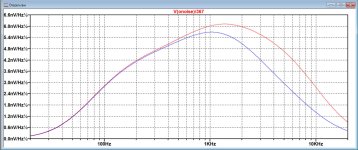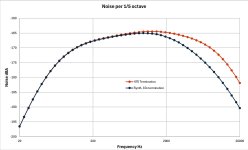Hi EC,
Sorry, I did not mean it is pointless all together, just that it technically it doesn't bring benefits when design is already well above target that can be achieved with given cart + LP limits.
It is about noise that I can confirm by listening, measurements and simulations is not an issue at all. Once I will install 4 resistors as you suggest to see if there are other benefits by ear
Sorry, I did not mean it is pointless all together, just that it technically it doesn't bring benefits when design is already well above target that can be achieved with given cart + LP limits.
It is about noise that I can confirm by listening, measurements and simulations is not an issue at all. Once I will install 4 resistors as you suggest to see if there are other benefits by ear
Hi,
Looking at synthesized loading, since I have gain of 40db in first stage, than resistors should be about of 2,4 Mega ohm , did I get it correct?
Looking at synthesized loading, since I have gain of 40db in first stage, than resistors should be about of 2,4 Mega ohm , did I get it correct?
Yes correct, the exact value should be (100-1)*23K7resistors should be about of 2,4 Mega ohm , did I get it correct?
Hans
Last edited:
Our auditory system perceives sound in terms of fractional octaves, not in units like V/√Hz.
Therefore, to align with human perception, the frequency axis should be presented on a logarithmic scale when displaying data in terms of octave bands.
This ensures equidistant spacing for each octave or fractional-octave step.
Additionally, sound level perception is inherently logarithmic.
To illustrate:
An octave from 10 kHz to 20 kHz spans the same perceptual "distance" as an octave from 10 Hz to 20 Hz. However, the absolute bandwidth is drastically different, leading to a 30 dB difference in energy (assuming white noise), even though both are perceived as one octave.
This highlights that plots in V/√Hz are misleading when evaluating perceived noise.
To correct for this, I have converted the original image (which displays A-weighted noise in V/√Hz) into a plot in dBA per 1/5-octave band.
The specific choice of 1/5-octave resolution is not critical; it mainly affects the vertical position of the curve (i.e., an offset) without altering its overall shape.
I selected 1/5-octave spacing as it offers a good trade-off between resolution and visual clarity of equidistant sampling on a log scale.
Hans
Therefore, to align with human perception, the frequency axis should be presented on a logarithmic scale when displaying data in terms of octave bands.
This ensures equidistant spacing for each octave or fractional-octave step.
Additionally, sound level perception is inherently logarithmic.
To illustrate:
An octave from 10 kHz to 20 kHz spans the same perceptual "distance" as an octave from 10 Hz to 20 Hz. However, the absolute bandwidth is drastically different, leading to a 30 dB difference in energy (assuming white noise), even though both are perceived as one octave.
This highlights that plots in V/√Hz are misleading when evaluating perceived noise.
To correct for this, I have converted the original image (which displays A-weighted noise in V/√Hz) into a plot in dBA per 1/5-octave band.
The specific choice of 1/5-octave resolution is not critical; it mainly affects the vertical position of the curve (i.e., an offset) without altering its overall shape.
I selected 1/5-octave spacing as it offers a good trade-off between resolution and visual clarity of equidistant sampling on a log scale.
- The first image shows the simulation results in the original V/√Hz format.
- The second image shows how the same noise would be perceived, represented in dBA per 1/5-octave.
Hans
Attachments
For calculating the S/N this will be perfectly o.k. but not to show how the noise spectrum will be perceived.No reason not to use V/√Hz
That’s why pink noise exists because white noise will be perceived louder as the frequency raises.
Hans
Not sure I follow your argument?
I'm not a fan of A-weighting. It allowed a simple instrument to produce a single figure result, but it's debatable as to how useful it is. There's now no reason not to plot noise as a function of frequency (as has been done in this thread). It has been argued that synthesised loading is scarcely necessary because the difference is unlikely to be audible. I would argue that not using synthesised loading unnecessarily degrades the high frequency signal to noise ratio of a moving magnet cartridge, making it significantly worse than a moving coil cartridge. If we can improve the engineering, we should.
I'm not a fan of A-weighting. It allowed a simple instrument to produce a single figure result, but it's debatable as to how useful it is. There's now no reason not to plot noise as a function of frequency (as has been done in this thread). It has been argued that synthesised loading is scarcely necessary because the difference is unlikely to be audible. I would argue that not using synthesised loading unnecessarily degrades the high frequency signal to noise ratio of a moving magnet cartridge, making it significantly worse than a moving coil cartridge. If we can improve the engineering, we should.
So in summary, to trow out 2 x 24k9 and install 2 x 2M49 ?
I don't have such high value in my drawers so I need to buy some, is 1% enough for this or better?
And then listen....
I don't have such high value in my drawers so I need to buy some, is 1% enough for this or better?
And then listen....
More than good enough.is 1% enough for this or better?
Looking forward to read about your experiences.
Hans
Those are very large shoes that have to be filled.I would argue that not using synthesised loading unnecessarily degrades the high frequency signal to noise ratio of a moving magnet cartridge, making it significantly worse than a moving coil cartridge
Let’s conclude that we have quite different views on more than one topic.
Hans
Don't know if that is such a good idea to this extent. Capacitive coupled common mode currents injected into the signal lines feeding the preamplifier can generate 100x common mode voltages that the input op-amp needs to then reject, although this is limited by the 100pF capacitances to ground. Otherwise it is looking good.So in summary, to throw out 2 x 24k9 and install 2 x 2M49 ?
I don't have such high value in my drawers so I need to buy some, is 1% enough for this or better?
And then listen....
Gerrit
Last edited:
NJM2068 is under rated , I am getting 85 dB s/n from AT VM95 cart
I have NJM2068 used in different applications, not DIY, and not in MM preamp so have no direct experience. Nevertheless I agree, it is very well measured for this application (and jellybean cheap) opamp.
It would be nice if you have balanced preamp and test it inside. Or show noise curve of what you have with diagram.
- Home
- Source & Line
- Analogue Source
- Fully balanced MC phono preamplifier thoughts

